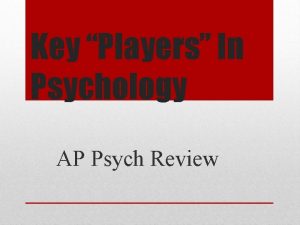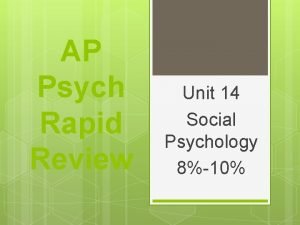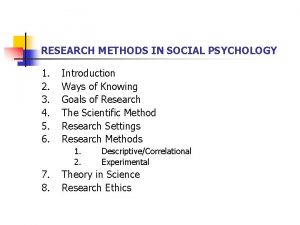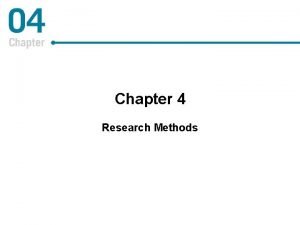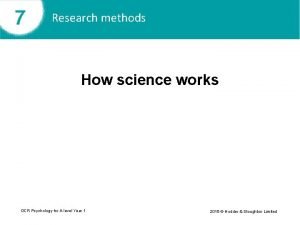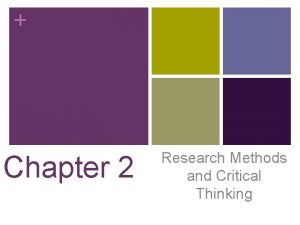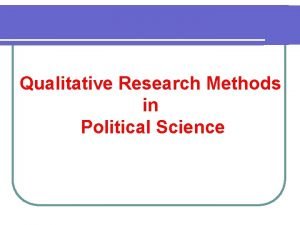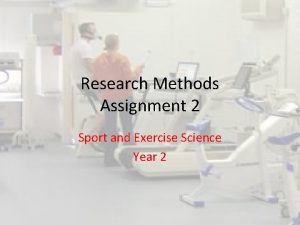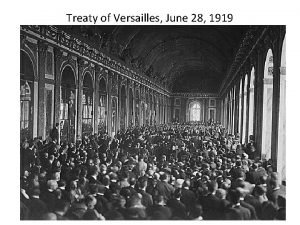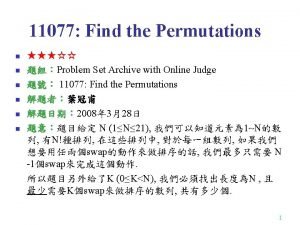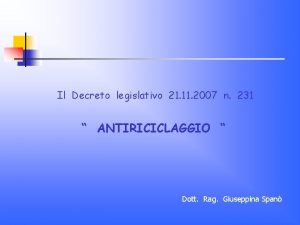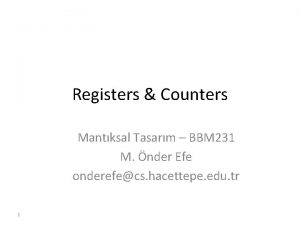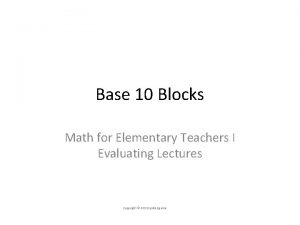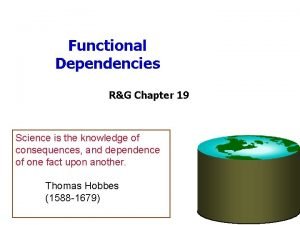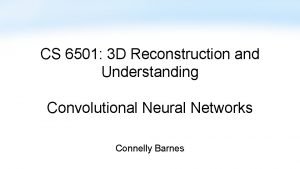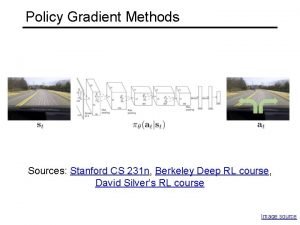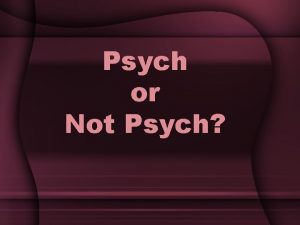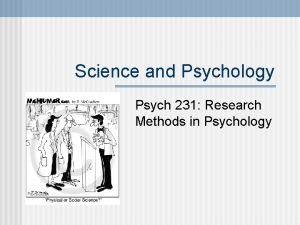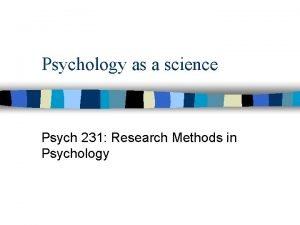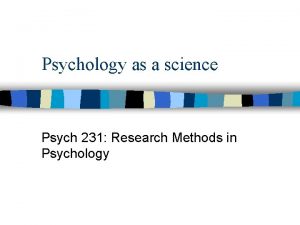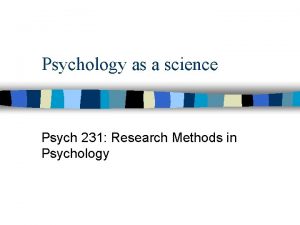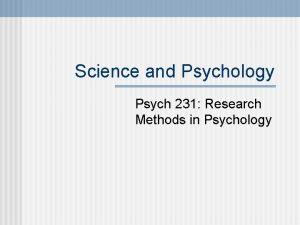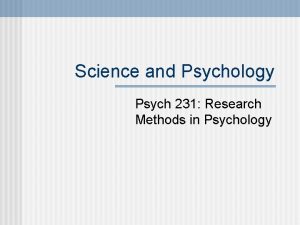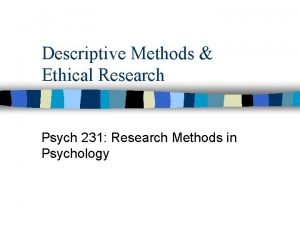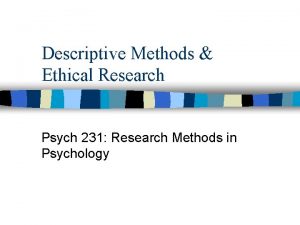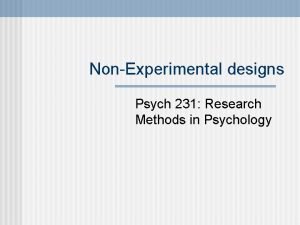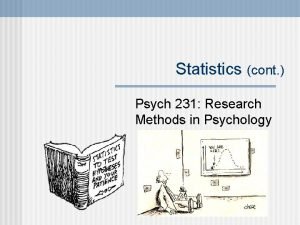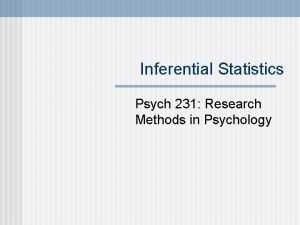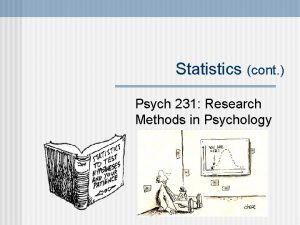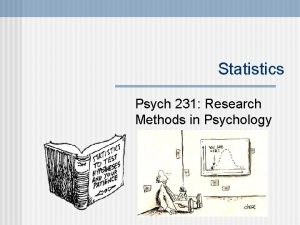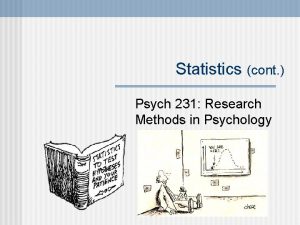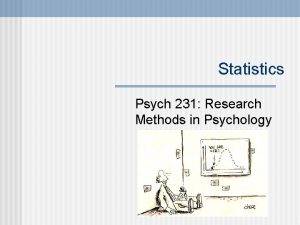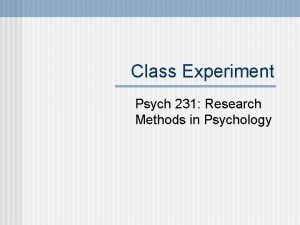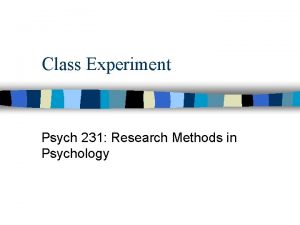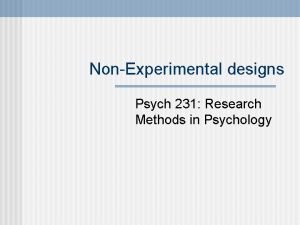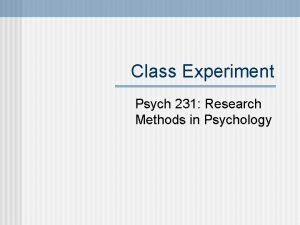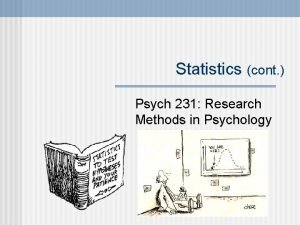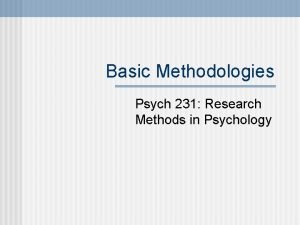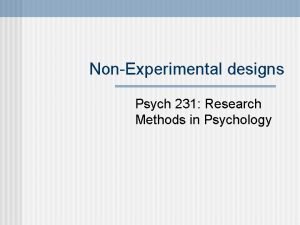The Science of Psychology Psych 231 Research Methods
























- Slides: 24

The Science of Psychology Psych 231: Research Methods in Psychology

n Download (full text available at library) and read the article for lab THIS week (Raz, Kirsch, Polard, & Nitkin. Kaner, 2006) Announcements

§ Discussion - the interpretation and implications of the results § Reading checklist 1 a) Does YOUR interpretation or the authors' interpretation best represent the data? b) Do you or the author draw the most sensible implications and conclusions? § § References - full citations of all work cited Appendices - additional supplementary supporting material The anatomy of a research article

n Write down the names of three scientists n n What field of science do they belong to? Write down the name of a famous psychologist n n Dr. Sigmund Freud, Dr. Phil Do they represent the standard psychologist? • NO! n Psychology is a diverse discipline • APA has 53 different divisions of psychology • And each of these has many different subgroups Psychology as a science

n What is science? What are the goals of science? n Is psychology a science? n n Yes • Studies the full range of human behavior using scientific methods • Applications derived from this knowledge is scientifically based Psychology as a science

n Psychology’s goals are similar to the goals of the physical sciences (e. g. , physics and chemistry) n n Psychologists are concerned with the behavior of people (and animals) rather than the physical world. How is psychology different from the physical sciences? n Human (and animal) behavior is typically much more variable than most physical systems. • Statistical control • Methodological control Psychology as a science

n Description of behavior n n Prediction of behavior n n Describe events, what changes what might affect change, what might be related to what, etc. Given X what will likely happen Control of behavior n For the purpose of interventions (e. g. , how do we prevent violence in schools) Goals of psychology

n Causes of behavior n n n Sometimes predictions aren’t enough, want to know how the X and the outcome are related Develop specific theories Explanation of behavior n n A complete theory of the how’s and why’s Given the diversity of psychology, some argue that we may never have a universal theory • This is a problem in other disciplines too Goals of psychology (cont. )

“My theory by A. Elk. Brackets Miss, brackets. This theory goes as follows and begins now. All brontosauruses are thin at one end, much thicker in the middle and then thin again at the far end. That is my theory, it is mine, and belongs to me and I own it, and what it is too. ” Theories Link to entire Monty Python’s “My theory” transcript

n Theory: n n “An interrelated set of concepts that is used to explain a body of data and to make predictions about the results of future experiments” Hypothesis: n Are specific predictions that are derived from theories (more specific than theories) (Stanovich, 2007: How To Think Straight About Psychology) Theories Link to entire Monty Python’s “My theory” transcript

Properties of a good theory

n Organizes, Explains, & Accounts for the data n If there are data relevant to your theory, that your theory can’t account for, then your theory is wrong • either adapt theory to account for the new data • develop a new theory that incorporates the new data Properties of a good theory

n n Organizes, Explains, & Accounts for the data Testable/Falsifiable – can’t prove a theory, can only reject it “No amount of experimentation can ever prove me right; a single experiment can prove me wrong. ” Properties of a good theory

n Beware theories that are so powerful/ general/ flexible that they can account for everything. These are not testable Omnipotent Theory

n Beware theories that are so powerful/ general/ flexible that they can account for everything. These are not testable n Karl Popper claimed that Freudian theory isn’t falsifiable • If display behavior that clearly has sexual or aggressive motivation, then it is taken as proof of the presence of the Id • If such behavior isn’t displayed, then you have a “reaction formation” against it. So the Id is there, you just can’t see evidence of it. n So, as stated, theory is too powerful and can’t be tested and so it isn’t useful Omnipotent Theory

n n n Organizes, Explains, & Accounts for the data Testable/Falsifiable Generalizable – not too restrictive n n The theory should be broad enough to be of use, the more data that it can account for the better The line between generalizability and falsifiability is a fuzzy one. Properties of a good theory

n n Organizes, Explains, & Accounts for the data Testable/Falsifiable Generalizable Parsimony (Occam’s razor) n for two or more theories that can account for the same data, the simplest theory is the favored one “Everything should be made as simple as possible, but not any simpler. ” Properties of a good theory

n n n Organizes, Explains, & Accounts for the data Testable/Falsifiable Generalizable Parsimony Makes predictions, generates new knowledge n a good theory will account for the data, but also make predictions about things that theory wasn’t explicitly designed to account for Properties of a good theory

n n n Organizes, Explains, & Accounts for the data Testable/Falsifiable Generalizable Parsimony Makes predictions, generates new knowledge Precision n makes quantifiable predictions Properties of a good theory

n Induction – reasoning from the data to the general theory n n So in complete practice this approach probably needs a new theory (or an adapted one) for every new data set Deduction – reasoning from a general theory to the data n n Here theory (if it is a “good” one) is sometimes viewed as more critical than the data. It also will guide the choice of what experiments get done Using theories in research

“Data driven research” Theory Induction Deduction Data n “Theory driven research” Typically good research programs use both The chicken or the egg?

n Basic (pure) research - tries to answer fundamental questions about the nature of behavior n n e. g. , Mc. Bride & Dosher (1999). Forgetting rates are comparable in conscious and automatic memory: A process-dissociation study. Applied research – Theory sometimes takes a backseat. This is research designed to solve a particular problem n e. g. , Jin (2001). Advertising and the news: Does advertising campaign information in news stories improve the memory of subsequent advertisements? Research Approaches

n Think of this is as a continuum rather as two separate categories. Basic research Applied research • Often applied work may bring up some interesting basic theoretical questions, and basic theory often informs applied work. Research Approaches

n Download (full text available at library) and read the article for lab THIS week (Raz, Kirsch, Polard, & Nitkin-Kaner, 2006) n Basic Methodologies n n Making observations and conducting experiments Read Chapters 6 and 7 Next Week
 Classical conditioning
Classical conditioning Attribution theory ap psych
Attribution theory ap psych Method of social psychology
Method of social psychology Research methods in developmental psychology
Research methods in developmental psychology Research methods in abnormal psychology
Research methods in abnormal psychology Ocr psychology research methods
Ocr psychology research methods Psychology research methods worksheet answers
Psychology research methods worksheet answers Qualitative analysis political science
Qualitative analysis political science Research methods in exercise science
Research methods in exercise science Conversation about favorite subject
Conversation about favorite subject Wax pattern fabrication pdf
Wax pattern fabrication pdf Acf 231
Acf 231 Article 231 of the treaty of versailles
Article 231 of the treaty of versailles 132 213
132 213 Phy 231 msu
Phy 231 msu 21112007 color
21112007 color Natal natal é vindo ao mundo o rei divinal
Natal natal é vindo ao mundo o rei divinal Gezang 231
Gezang 231 Counter with unused states
Counter with unused states Cs 231
Cs 231 Walfisch ikegami model
Walfisch ikegami model Draw 231 with base ten blocks
Draw 231 with base ten blocks 040 231 3666
040 231 3666 Mvcnn pytorch
Mvcnn pytorch 231n stanford
231n stanford
